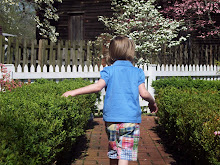Visit a pumpkin patch to pick your own pumpkins, walk the fields and teach your little one how pumpkins grow. Cut your own pie pumpkins to take home for a yummy (and sticky, messy, ooey, gooey) science experiment!
Sing "Five Little Pumpkins" which is also illustrated in the book titled the same.
Five little pumpkins sitting on a gate
The first one said "Oh my, it's getting late!"Science Experiment:
The second one said, "There are witches in the air!" (can also insert bats, owls for witches)
The third one said, "...but we don't care!"
The fourth one said, "Let's run and run and run!"
The fifth one said, "We're having so much fun!"
Then whoosh went the wind! (wave arms in air)
And out went the light (clap hands together on "out")
And the five little pumpkins rolled (roll your fists over each other) out of sight (hide hands behind back).
Let your preschooler hold a pie pumpkin and predict what might be inside the pumpkin. Let her draw a picture on the "What's inside a pumpkin?" worksheet of what she predicts.
Then cut the pie pumpkin while she watches and see if her prediction was true or false. (Mae predicted that a purple sucker was going to be inside the pumpkin) Let your child draw the stringy pulp with an orange crayon, pencil or marker. Or let him glue on orange yarn with school glue. Then glue down pumkin seeds. Ask your child questions such as, "How does the pulp feel?" "What can we do with the seeds?" "
Use words such as slimy, cold, gooey, slippery,etc...
Explain how pumpkins grow: on a vine, from seeds planted in the dirt, on the ground, etc...
What Sins Idea Pumpkin
Cook the pumkin: Scoop all the pulp and seeds from the pumpkin and wrap the rest of the pumkin with aluminum foil and place on a foil-lined jelly roll pan. Place in a 350 preheated oven and bake for about 45 minutes or until soft on the inside. Allow to cool and remove the "meat" of the pumpkin from the shell. Mash with a potato masher and use in a recipe that requires pumpkin (substitue for can pumpkin). Allow your child to be as involved in this process as possible for his/her age and abilities. Be sure to stretch his or her abilities by letting him or her try something new :-) It WILL be messy!!
Roast the seeds and toss in salads or in pastas for yourself. I wouldn't reccommend serving pumpkin seeds to children under age 4 or 5.
Allowing your children to help in the kitchen teaches them science and math skills, how to follow directions and will promote healthier eating habits.
Read "Apples and Pumpkins" by Anne Rockwell. Describe the difference between the way pumpkins grow (down low on a vine) and the way apples grow (up high in a tree).
Extra Activity:
Pumpkin Patterns Sheet
Pumpkin Patterns
